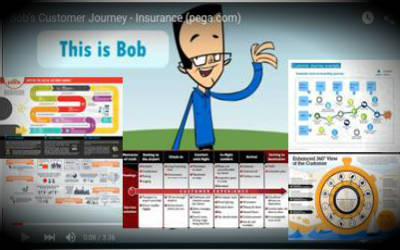
Rethinking Online Marketing
It used to be that one could decide, almost on a whim, to put a business on the web and expect some results with minimal online marketing efforts. If you have tried this recently, you know it is definitely not the case today.
Despite not having a reliable worldwide statistics on how many online businesses are started each year, we can extrapolate (mostly from US data) that the number of new online businesses worldwide is in the tens of millions yearly. Almost as many fail, but the web is still left with a fast growing number of businesses.
So what can you do, as an online retailer, to find, keep and delight customers?
The web is crowded today. It will be exponentially more crowded in the future as putting a business online gets easier.
Try to imagine a shopping mall with hundreds of thousands of easily reachable businesses who want to sell to you. The mall is so packed that you can’t really see any of the stores unless you are in front of them. The inventory they hold is mind boginly huge.
Now that the image has sunk in, ask yourself if these businesses were to use the online marketing techniques currently used by ebusinesses, would you want to buy from them?
Using this same analogy, would you buy from any of these businesses in that mall if:
- While you are walking around, you spot an interesting information billboard and stop to read it. As you start reading, a bunch of retailers come out of their store and start talking to you, some even standing between you and the billboard, about their products that you have no interest in.
⇒ Online, mobile an pop-up ads - While you walk around the mall hundreds of retailers you have never heard of chase you and stuff little messages in your pockets.
⇒ spam, unwanted emails - While you were in the mall, a store caught your attention and you went inside to look at a display that turned out to be uninteresting. Ever since that moment, the retailer pops up everywhere you look and keeps showing you the products on the display you looked at.
⇒ uninformed re-targeting
The answer to whether you would want to buy from any of them is, for the vast majority, a resounding no.
Yet, this is how most online marketing is currently done.
So now, let’s try to figure out what it would take for you to not only notice one of these businesses in the mall of over plenty but want to buy from this retailer repeatedly.
The web marketing/advertising community is starting to take steps in one of the right directions. The other directions we have yet to figure out.
A growing number of recent online promotional and advertising techniques are yielding good results. These techniques share two commonalities:
- They answer a real need in the correct way
- They contribute to building a relationship with the customer
Answering a need
A need can be latent or expressed. It can be that of a customer segment (defined as sharing a same need) or of a single customer. The underlying implication is that the need, and its context, are known. This in turn implies that effort has been put into thoroughly understanding customers’ needs, and their context, as well as being able to adapt to the various ones in the segments you target.
Building a relationship
 A relationship is the away a person communicates, behaves and deals with someone else based, in large part, on the level of trust between them.
A relationship is the away a person communicates, behaves and deals with someone else based, in large part, on the level of trust between them.
It used to be that customers bought from their local merchants. The merchants spent time talking and getting to know their customers and their families and vice versa. Customers would see their merchant at the village church or in other social settings. They knew where and how the merchant lived. All this information increased trust and facilitated the building of a relationship between customers and the merchant.
The villages eventually grew into large cities. Merchants became strangers who sold brand name products created by faceless corporations. The only information available to customers to build a relationship pertained to the brand and it was controlled. As we all know, the brand information we receive is rarely sufficient to get the entire or even the real picture.
The advent of social media is now allowing a glimpse, and what may soon become a full view, into not only the brand and the corporation but also how the owners and employees manage it. This last information is much more relevant to consumers to build relationships than information on brand or company is.
We are now back to our mall of plenty analogy. Let’s say you are there shopping for some gluten free chocolate to give to your spouse for Halloween.
- As you are walking around you spot an interactive billboard on gluten free treats for Halloween and you stop to read. As you select to get more information on chocolates, a few merchants come out of their shops to talk with you. They pleasantly ask you questions on your purchase intentions, on your spouse’s preferences and your own. The merchants who know they have products that answer the needs they just discovered ask if you would like more information on their chocolate selection. They thank you and wish you a good day.
⇒ Bi-directional, targeted promotional information - As you continue walking about the mall, two of the retailers, who you accepted to get information from, come to offer you gluten free chocolate samples and give you information on their selection and prices. They also engage you in a short conversation with the goal of getting to know you better. One of the retailers quickly picks up that you are a sniper shopper (target what you want beforehand, go for it and leave the shop quickly). She offers to present you only the chocolates that fit your spouse’s taste and have access to an express checkout line.
⇒ Targeted email and tailored shopping experience - You end up purchasing from this retailer. Over the next few months, the retailer you purchased from sends you occasional and useful information, discounts on gluten-free food items and offers you a free membership to a local information sharing community of people living with someone on a gluten free diet they manage. Fast forward to February, you are back at the mall of plenty to get your spouse a box of Valentine chocolates. As you walk in, your Halloween chocolate merchant comes to greet you with a smile and a discount offer on a beautifully wrapped box of gluten free chocolates you know your spouse will like.
⇒ Targeted offer based on accurate need information
Seriously, if this was the scenario, would you spend any energy shopping around given you are a sniper shopper?
The approaches used by the retailers in the above scenarios are all based on understanding the needs of their customer and building a relationship with him/her.
Ask yourself if your current promotional and advertising efforts on the web are based on answering your customers’ needs and contributing to building a relationship with them. If not, you may soon be replaced by a competitor who will.


